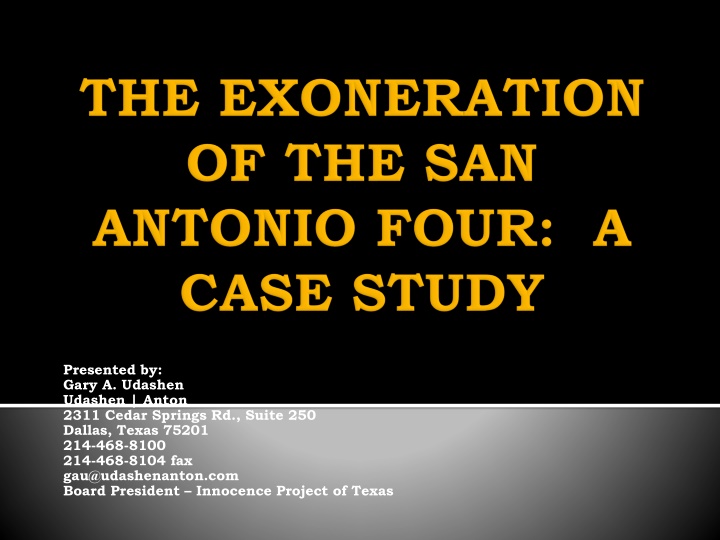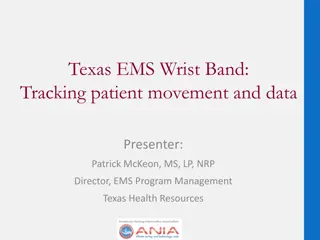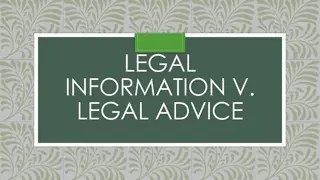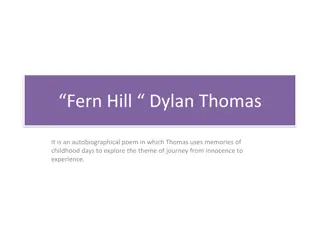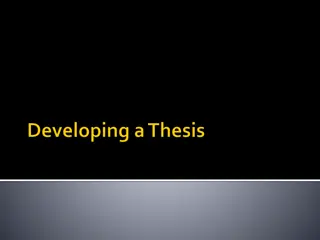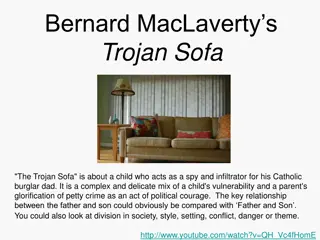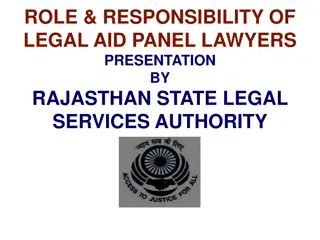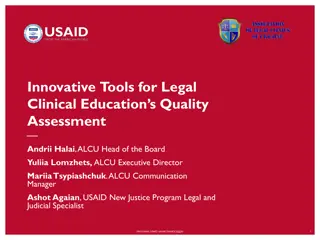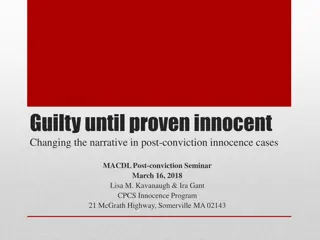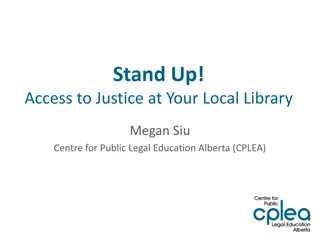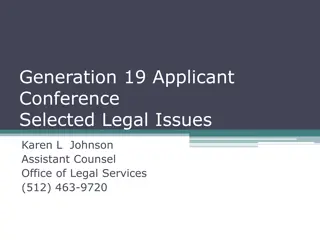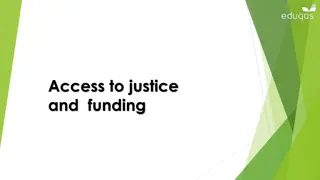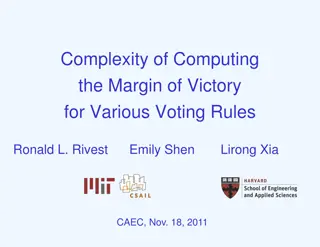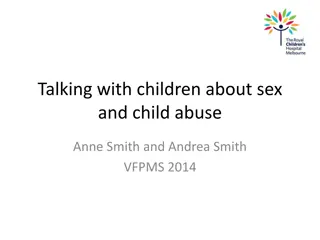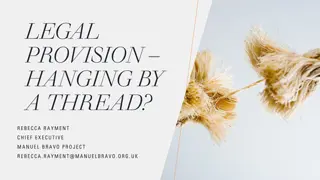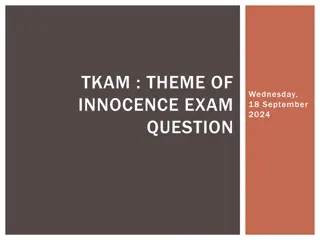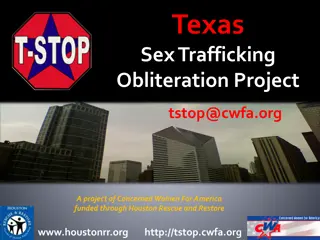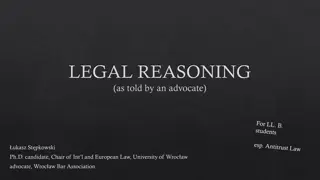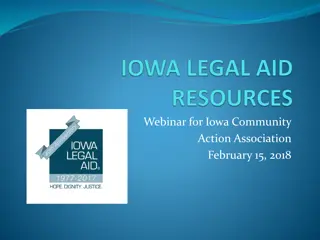Innocence Project of Texas Legal Victory
Kristie Mayhugh, Elizabeth Ramirez, Cassandra Rivera, and Anna Vasquez, known as the San Antonio Four, were found actually innocent in a landmark case based on newly discovered evidence and expert testimonies. This legal victory highlights the flaws in the justice system and the importance of perseverance in seeking justice.
Download Presentation

Please find below an Image/Link to download the presentation.
The content on the website is provided AS IS for your information and personal use only. It may not be sold, licensed, or shared on other websites without obtaining consent from the author.If you encounter any issues during the download, it is possible that the publisher has removed the file from their server.
You are allowed to download the files provided on this website for personal or commercial use, subject to the condition that they are used lawfully. All files are the property of their respective owners.
The content on the website is provided AS IS for your information and personal use only. It may not be sold, licensed, or shared on other websites without obtaining consent from the author.
E N D
Presentation Transcript
Presented by: Gary A. Udashen Udashen | Anton 2311 Cedar Springs Rd., Suite 250 Dallas, Texas 75201 214-468-8100 214-468-8104 fax gau@udashenanton.com Board President Innocence Project of Texas
Kristie Mayhugh Elizabeth Ramirez Cassandra Rivera Anna Vasquez Ex parte Mayhugh, 512 S.W.3d 285 (Tex. Crim. App. 2016) Found actually innocent by Court of Criminal Appeals on November 23, 2016
Two young girls testified that the four women sexually assaulted them One of the girls, now an adult, recants accusations Other girl does not recant Recantation supported by expert testimony State s medical evidence, that one of the girls had physical signs of abuse, is recanted by doctor based on new science
We conclude that now, with this clear and convincing evidence establishing innocence combined with the lack of reliable forensic opinion testimony corroborating the fantastical allegations in this case, no rational juror could find any of the four Applicants guilty of any of the charges beyond a reasonable doubt. Court of Criminal Appeals, November 23, 2016
According to Applicants expert, Dr. Alexandria Doyle, the sexual-assault allegations in this case do not pass the smell test. This emotional response certainly captures the sense of outrage that so many harbor about these cases. Whether it is in articles or a documentary, these cases involving The San Antonio Four have been well dissected in popular media. See e.g. Southwest of Salem: The Story of the San Antonio Four (Deborah S. Esquenazi Productions 2016); Bridget Dunlap, Inside Case Behind Wrongful Conviction Doc Southwest of Salem , ROLLING STONE, Oct. 13, 2016; Maurice Chammah, Case of San Antonio Four Set to Enter its Final Act, THE TEXAS TRIBUNE, March 29, 2015; Maurice Chammah, A Growing Battle for Exoneration, N.Y. Times, Nov. 18, 2012.
Actual Innocence: Newly Discovered Evidence Unquestionably Established Innocence New Science Under Art. 11.073, Code Criminal Procedure
Free Standing Actual Innocence Claim: Ex Parte Elizondo, 947 S.W.2d 202 (Tex. Crim. App. 1996) Applicant must show, by clear and convincing evidence, that newly discovered or newly available evidence of actual innocence unquestionably established innocence.
Newly discovered evidence is evidence that was not known to the applicant at the time of trial and could not have been known to him even with the exercise of due diligence. Brown, 205 S.W.3d 538 Newly available evidence is evidence that may have been known to the applicant but was not available for his use based on factors beyond his control. Calderon, 309 S.W.3d 64
Court must examine the new evidence in light of the evidence presented at trial To grant relief court must believe that no rational juror would have convicted in light of the newly discovered evidence.
Applies to: DNA New Scientific Evidence Recantations New Witnesses Other New Evidence
Defendant found actually innocent based on newly discovered evidence, including evolution science of bitemark comparisons, undisclosed Brady material and post- conviction DNA testing of evidence excluding defendant as contributor. of body of
Cacy convicted of an arson murder based on false lab report that claimed there was gasoline on her uncle s clothing. Trial Court finds Cacy is actually innocent. Court of Criminal Appeals Agrees
One alleged victim recanted her testimony Alleged victim stated it was her abusive father who instigated the claims Circumstances and timing of recantation were not suspicious according to expert evaluation
Recantation was corroborated by testimony of girls mother that father had engaged in pattern of false abuse allegations to gain leverage in legal disputes New medical testimony established there was no physical evidence of sexual assault Expert testified that defendants did not fit profile of sex offenders
QUESTION: HOW SHOULD COURTS RESPOND TO CHANGES IN SCIENCE UNDERLYING CONVICTIONS
Art. 11.073. Procedure Related to Certain Scientific Evidence. (a) This article applies to relevant scientific evidence that: (1) was not available to be offered by a convicted person at the convicted person s trial; or (2) contradicts scientific evidence relied on by the state at trial: (b) A court may grant relief if . . . : (A) relevant scientific evidence is currently available and was not available at the time of the convicted person s trial because the evidence was not ascertainable through the exercise of reasonable diligence by the convicted person before the date of or during the convicted person s trial; and
(B) the scientific evidence would be admissible under the Texas Rules of Evidence . . . ; and (2) the court . . . finds that, had the scientific evidence been presented at trial, on the preponderance of the evidence the person would not have been convicted. (c) For purposes of a subsequent writ, a claim or issue could not have been presented in a previously considered application if the claim or issue is based on relevant scientific evidence that was not ascertainable through the exercise of reasonable diligence by the convicted person on or before the date on which the original application or a previously considered application , as applicable, was filed.
(d) In making a finding as to whether relevant scientific evidence was not ascertainable through the exercise of reasonable diligence on or before a specific date, the court shall consider whether the field of scientific knowledge, a testifying expert s scientific knowledge, or a scientific method on which the relevant scientific evidence is based has changed since . . .
Relief granted under 11.073 on murder case based on change in body of scientific knowledge in field of bitemark comparisons Experts opinions that human bitemarks were unique and an individual could be identified as source of bitemark discredited by new science.
Relief granted under 11.073 to four defendants, three who pled guilty to sexual assault, and one who was convicted of capital murder Y-STR DNA testing results were exculpatory to all four defendants and constitute new scientific evidence
A showing by a mere preponderance of the evidence that an applicant would not have been convicted if exculpatory DNA results are obtained is not sufficient to warrant relief on the basis of actual innocence, but statute governing procedure on new scientific evidence (Art. 11.073) affords an avenue for relief under the preponderance standard.
States medical expert, Dr. Nancy Kellogg, at trial testified that one of the alleged victims showed physical, objective signs of sexual abuse Dr. Kellogg s testimony in trials in 1997 and 1998 was that she observed a hymenal scar on one of the girls hymens Dr. Kellogg testified that the scar was caused by penetration with an object
In 2013, Dr. Kellogg signed affidavit stating: At time of her trial testimony, it was believed that injuries to hymen often left observable scars or evidence of healing Recent scientific studies now show that, while this can occur, it is uncommon
Her current review of the childs examination slides are non-specific for trauma If the new scientific information had been available at the time of trial, she would not have testified that the finding was indicative of trauma to hymen
